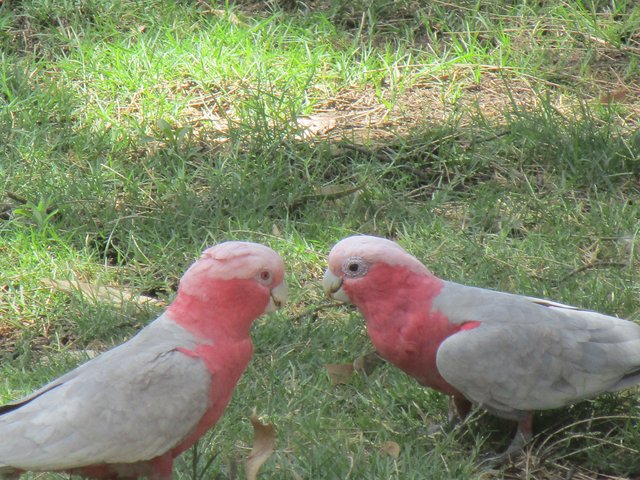Commonly referred to as a Galah.

 )
)
(Taken from https://backyardbuddies.org.au/)
Galahs are a common site in our backyards. Whether they are hanging upside-down on a telegraph line, bobbing their heads in a dance or playing soccer with pebbles on the ground, you will see why ‘galah’ is Aussie slang for a silly person.
Galahs live all over Australia and mostly spend their days sheltering in trees or shrubs before congregating later in the day in huge noisy flocks. It is not uncommon to see them almost completely covering a tree, or a large group on a grassed area feeding on grass seeds.
Male and female Galahs mate for life. They will spend most of their time together in pairs, eating, cleaning and playing together. They are a very social and affectionate bird.
They mostly feed on the ground, and retreat to the shade of tree branches during the hottest parts of the day. Plant locally native grasses, bushes and shrubs in your backyard to provide them with a food source.
The male and female Galahs look almost identical with their pink and grey feathers. To help you tell them apart, check the colour of their eyes. The male Galahs have dark-brown or black eyes while the females have pink or red ones.
Galah pairs will continue to return to the same nest site every year and will defend it from other Galahs or animals. Both parents get the nest ready for the eggs by lining it with soft eucalyptus leaves.
Galahs like to keep their beaks sharp by chewing on branches. While breeding, they will do most of their chewing on one branch near the nest which is used as a sign to others that this nest is occupied.
The female Galah will lay 4 to 6 eggs in her tree hollow but unfortunately only half will usually survive. However once the chicks make it to adulthood they will usually live for about 25 years in the wild or up to 80 years when kept as pets.
When the young Galahs are ready to leave their nest the parents will continue to look after them for a few weeks but then they will become independent.
Like other cockatoos, the Galah is an excellent mimic of voices and sounds. Their vocal talents, along with their colour and hilarious personalities, have made them a very popular pet choice.
Galahs love to eat seeds which means they will spend a lot of time on the ground. This is great for spotting them and taking good photos but can make them vulnerable to foxes and other predators. Luckily they feed in large flocks where there are plenty of look-outs to warn of approaching danger.
There are several different subspecies of Galah but they all look very similar and can be found right across Australia. It is believed that they were introduced to Tasmania but are now a common sight there. The Galah is very easy to recognise from its bright pink feathers and the loud ‘chi, chi’ call they make. They can grow to 36cm long and the males are usually slightly larger.
Galahs have successfully adapted to suburban areas because of the plentiful water and seeds available in parks, farms and backyards. But with urban sprawl and land clearing, the loss of our large trees makes it hard for them to find permanent nesting sites.

 such a pretty colours
such a pretty colours